Founded in 2004 by George Petersen and presented since 2015 by the NAMM MUSEUM of Making Music, the TECnology Hall of Fame honors and recognizes audio products and innovations that have made a significant contribution to the advancement of audio technology. Inductees to the TECnology Hall of Fame are selected by a panel of more than 50 recognized audio experts, including authors, educators, engineers and other professionals. Products or innovations must be at least 10 years old to be considered for induction.
Past Inductees: 2015 | 2016 | 2017 | 2018 | 2019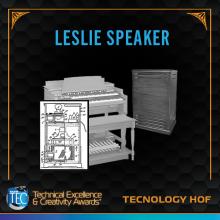
Initially, the Hammond organ was intended for the church and home markets, but it was the debut of the semi-portable (meaning only 400 pounds!) model B-3 in 1954 that brought this instrument to the forefront of jazz, R&B and rock-n-roll. The B-3 was the right instrument at the right time, but its soulful versatility and great voicings (combined with Don Leslie’s rotating speaker design) that soon made the instrument a mainstay in every genre of pop music.
Originally patented as a “Rotatable Tremulant Sound Producer” (U.S. patent #2,489,653, filed on July 9, 1945), the Leslie design shown in the diagram was unlike any conventional speaker in that the output of the tweeter (#1) fed a rotating horn (#4), and the down-firing woofer (#2) fed into a rotating drum (#5). Both the treble and bass sections had slits in the otherwise-sealed enclosure and the sounds emanating from the cabinet used the Doppler effect to create a swirling sound.
Eventually the Leslie speaker was upgraded with both high and low speed rotational settings and even a brake function — all of which could be used to creative effect by both organists, and later guitarists, via a pedal controller. Today, many keyboard instruments include a simulation of the Leslie rotating speaker effect, but these pale in comparison to the original, because even today, there ain’t nothing like the real thing.
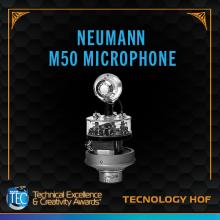
At the same time that Neumann unveiled the M49 (its first remotely controlled microphone), the company also launched the M50, a single-pattern omnidirectional tube model designed specifically for the needs of classical music recording.
The M50 is unique among other microphones, as its small-diameter condenser capsule is located in the center of a clear, 4 cm acrylic sphere (shown here with the outer grill removed) which results in a rising, yet smooth high-frequency response (about +6 dB) from 8k Hz to 16k Hz, while the response is much flatter at lower frequencies. And while the mostly omnidirectional at lower frequencies, the M50 exhibits increasing directivity towards higher octaves.
In 1954, two engineers at London's Decca Records devised a creative solution for stereo recording. The result — which became known as the "Decca Tree" — consists of three widely spaced M50 microphones on an overhead T-shaped mount, with outer left and right mics and a third mic in the center. The results were astonishingly smooth and natural, whether used in symphony halls, chamber ensembles or scoring sessions in recording studios. In fact, even today, this “Decca Tree” technique is still considered the world standard for classical recording.
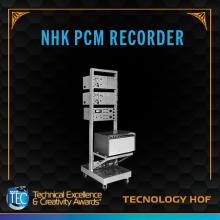
Ironically, the first digital tape recorder did not come from an industrial giant like Sony, but from the R&D laboratories of the Technical Research Institute of Japanese public broadcaster NHK (Nippon Hōsō Kyōkai). The project was spearheaded by Dr. Heitaro Nakajima — no stranger to cutting edge product development, having (among other projects), developed the prototype for what became Japan’s first condenser microphone — Sony’s C-37A in 1955. Years later, Nakajima also was instrumental in Sony’s co-development of the compact disc with Phillips Electronics.
Nakajima believed that digital PCM (Pulse Code Modulation) techniques were key to creating recordings that could surpass the existing analog recordings of the time. While crude by modern standards, Nakajima’s 1967 design for the first digital audio recorder was a single-channel system using a 12-bit companded scheme and 30 kHz sampling rate.
This machine was a 12-bit companded scheme (using a compression / expansion of sound to improve dynamic range) with a 30 kHz sampling rate. Audio data was captured from the A/D converters onto a one-inch helical scan VTR that resided in the rack below the record/play electronics. The results weren’t amazing, but proved that the process was workable, and two years later, was followed up by a 13-bit stereo recorder that captured audio at 47.25 kHz onto a 2-inch VTR.
After the news spread of the NHK prototypes, other digital recorder projects were launched by Denon, the BBC, Sony, Hitachi, Mitsubishi and others — both as fixed-head and VTR-based systems. And the rest is history.
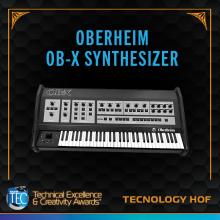
Synth pioneer Tom Oberheim has a long and storied career in the development of electronic music instruments and tools, ranging from guitar amplifiers in his early days, to creating Maestro’s classic RM-1A ring modulator and PS-1 phase shifter pedals. He was the first ARP Instrument dealer on the West Coast. He showed his first 2-note synth at the AES show in 1974. This was followed by his 2-, 4- and 8-voice synths under the Oberheim brand and in 1977, created the OB-1, the first programmable monophonic programmable synthesizer. He also launched a hardware polyphonic digital sequencer (DSX), the DMX sampled sound drum machine and the OB-X — all of which formed the “Oberheim System” — a pre-MIDI production environment. Ironically, a few years later, Oberheim was involved in the team that created the MIDI standard, which made his system obsolete.
Shipping in June 1979, the Oberheim OB-X was a polyphonic (4/6/8-voice) analog subtractive synthesizer whose rich, powerful and lush sounds — thanks in no small part to its Oberheim S.E.M. filters — made it an instant success and it soon found itself being used by artists ranging from Rush, to Queen, to Madonna, Styx, Prince and even Jean-Michel Jarre.
Other versions followed, adding features and flexibility, but retaining that classic Oberheim sound. And even today at age 85, Tom Oberheim shows no signs of slowing down, and will be launching the new OB-X8 — a new, expanded version of the OB-X — at The 2022 NAMM show.
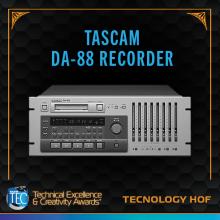
Housed in a compact, 4-rackspace chassis, the TASCAM DA-88 digital 8-track deck can record 108 minutes of digital audio on a standard Hi-8mm videotape. Unlike the process of synching two or more analog recorders, DA-88s did not require the use of audio tracks or expensive external synchronizers for multi-machine lockup; a single cable could provide sample-accurate synch.
One advantage of the modular design was that users could start out with an 8-track unit and add more DA88s to expand the system to 16-, 24- or more tracks. That modular digital multitrack approach allowed up to 16 of these $4,499 machines to be interlocked, providing up to 128 tracks (in 8-track increments) of recording capability.
Eventually, by the turn of the (20th) century, DAWs such as Pro Tools, fueled by computers with powerful processors, ample RAM and low-cost disk storage — spelled the demise of the digital tape revolution.
